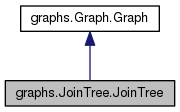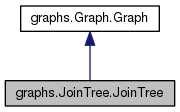 |
Quantum Fog
0.9.3
|
 |
Quantum Fog
0.9.3
|


Public Member Functions | |
| def | __init__ (self, tri_gra, bnet) |
| def | set_clique_and_sepset_pots_to_one (self, is_quantum) |
| def | init_clique_potentials_with_bnet_info (self) |
| def | mask_clique_potentials (self) |
| def | describe_yourself (self) |
 Public Member Functions inherited from graphs.Graph.Graph Public Member Functions inherited from graphs.Graph.Graph | |
| def | __init__ (self, nodes) |
| def | add_nodes (self, nodes) |
| def | has_node (self, node) |
| def | contains (self, nodes) |
| def | unmark_all_nodes (self) |
| def | get_node_named (self, name) |
| def | get_node_with_id_num (self, id_num) |
| def | get_node_with_topo_index (self, topo_index) |
| def | get_nx_graph (self) |
| def | draw (self, algo_num, kwargs) |
| def | write_dot (self, path) |
| def | read_dot (cls, path) |
Static Public Member Functions | |
| def | get_bnet_cliques (tri_graph, bnet) |
| def | get_clique_owner (subgraphs, clique) |
| def | merge_subgraphs (sepset, strong_g, weak_g) |
 Static Public Member Functions inherited from graphs.Graph.Graph Static Public Member Functions inherited from graphs.Graph.Graph | |
| def | new_from_nx_graph (nx_graph) |
Additional Inherited Members | |
 Public Attributes inherited from graphs.Graph.Graph Public Attributes inherited from graphs.Graph.Graph | |
| nodes | |
JoinTree is the final undirected graph that is constructed for JoinTreeEngine. The nodes of a JoinTree are cliques. Cliques are themselves sets of subnodes. The cliques are determined in a previous step which involves building a TriangulatedGraph. The Sepset's ( separation sets) are not nodes of the JoinTree graph. A clique stores a sepset for each clique adjacent to it. Attributes ---------- nodes : set[Node]
| def graphs.JoinTree.JoinTree.__init__ | ( | self, | |
| tri_gra, | |||
| bnet | |||
| ) |
Constructor Parameters ---------- tri_gra : TriangulatedGraph bnet : BayesNet Returns -------
| def graphs.JoinTree.JoinTree.describe_yourself | ( | self | ) |
Prints a pretty summary of the attributes of self. Returns -------
|
static |
The TriangulatedGraph returns cliques whose subnodes are COPIES of the nodes in the original Bnet. This method swaps the subnodes of each clique by the original bnet nodes, the real McCoy. This method modifies tri_graph (stomps on it) now that it has already served its purpose of finding the cliques. Parameters ---------- tri_graph : TriangulatedGraph bnet : BayesNet Returns ------- list[Clique]
|
static |
From a list of subgraphs called 'subgraphs', find a subgraph that contains the nodes of clique. Parameters ---------- subgraphs : list[Graph] clique : Clique Returns ------- Graph
| def graphs.JoinTree.JoinTree.init_clique_potentials_with_bnet_info | ( | self | ) |
Once the Clique potentials have been set to one, multiply them times the conditional PDs or conditional PADs of the nodes of the CBnet or QBnet. A clique accepts only the PD or PAD of those nodes that contain all their family inside that clique. abbreviations in MyConstants.py. Returns ------- None
| def graphs.JoinTree.JoinTree.mask_clique_potentials | ( | self | ) |
Masks clique potentials assuming they have been constructed already. Returns ------- None
|
static |
This merges two JoinTree subgraphs called strong_g and weak_g and labels the merged result strong_g. (That is why it is called strong_g; because it is the one of the 2 that survives). To link the 2 subgraphs, the two cliques in 'sepset' are made neighbors and 'sepset' is put into their sepset lists. Parameters ---------- sepset : Sepset strong_g : Graph weak_g : Graph Returns ------- None
| def graphs.JoinTree.JoinTree.set_clique_and_sepset_pots_to_one | ( | self, | |
| is_quantum | |||
| ) |
This sets clique and sepset pots to 1 over all states of their subnodes, not just over the active ones. If 1 over the active states and 0 over the inactive ones is desired, next apply mask_self() to the potential. is_quantum is needed because pot_arr will be type float64 in the CBnet case and type complex128 in the QBnet case. Parameters ---------- is_quantum : bool Returns ------- None
 1.8.11
1.8.11